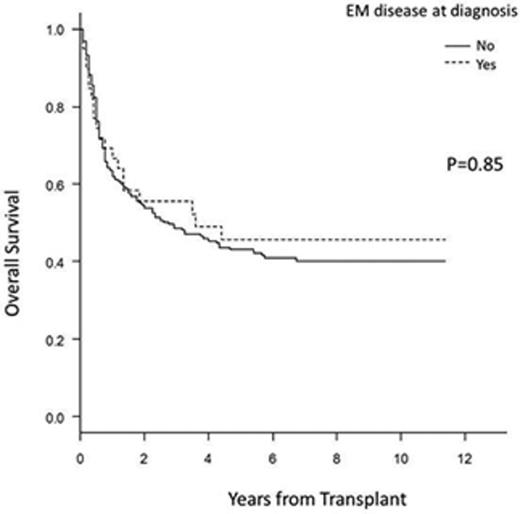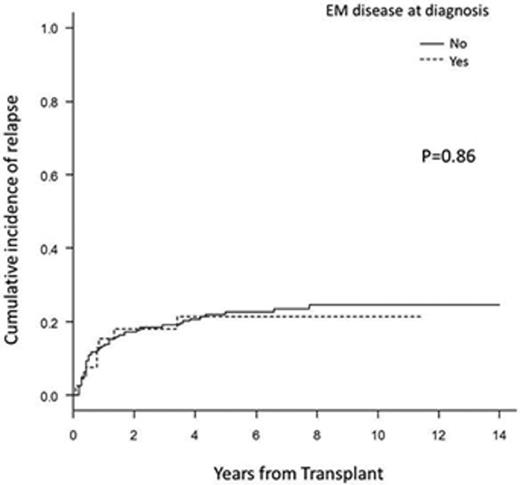Abstract
Occurrence of extramedullary (EM) disease at diagnosis of acute myeloid leukemia (AML) has been associated with increased risk of relapse and worse outcomes post-chemotherapy. There is minimal data in the literature concerning the association with outcomes following allogeneic hematopoietic cell transplantation (HCT). The purpose of this single-centre study was to retrospectively investigate the impact of EM disease at diagnosis on the outcome of 303 patients with AML in first complete remission (CR1) that underwent HCT during the time period 2000-2013.
Median age at HCT was 51 years (range 18-71), 151 (50%) patients were female. Myeloablative conditioning (MAC) was used in 202 (67%) patients, reduced-intensity (RIC) in 101 (33%) patients. Donors were related for 194 (64%) patients, unrelated for 109 (36%) patients. Grafts were peripheral blood stem cells (PBSC) in 253 (83%) patients and bone marrow in 50 (17%) patients. Median follow-up of patients alive was 63 months (range 12-168). Cytogenetics at diagnosis were available for 263 (87%) of patients, of which 16 (5%) were favorable, 185 (61%) were intermediate and 62 (20%) were unfavorable risk (MRC classification). Primary induction failure prior to achievement of CR was seen in 67 (22%) patients. In vivo T-cell depletion was performed in 71 (23%) patients. A total of 124 patients (41%) underwent HCT during the years 2000-2006 and 179 patients (59%) during the years 2007-2013. EM disease at diagnosis was seen in 39 patients (13%), of whom 11 patients had CSF disease, 7 patients had gingival infiltration and 5 patients had leukemia cutis.
Univariate analysis for overall survival (OS) demonstrated that EM disease at diagnosis had no influence (HR=0.96 for EM, 95%CI=0.60-1.51, p=0.85, Figure 1). Multivariable analysis for OS including the previously described variables verified this observation. EM disease did not influence cumulative incidence of relapse (CIR) on univariate analysis (HR=0.94 for EM, 95%CI=0.45-1.96, p=0.86, Figure 2), and this also was confirmed on multivariable analysis. Moreover, EM disease did not influence cumulative incidence of non-relapse mortality on both univariate (HR=0.94 for EM, 95%CI=0.53-1.66, p=0.83) and multivariable analysis.
In conclusion, EM disease at diagnosis of AML in patients achieving CR1, does not seem to influence outcomes post allogeneic HCT. This is significant in the consideration of allogeneic HCT for the treatment of this unfavorable subtype of AML. We are unable to comment on whether a similar percentage of patients with EM disease versus without EM disease, achieve CR1.
Kim:Bristol-Myers Squibb: Consultancy, Research Funding; Novartis Pharmaceuticals: Consultancy, Research Funding.
Author notes
Asterisk with author names denotes non-ASH members.



This feature is available to Subscribers Only
Sign In or Create an Account Close Modal